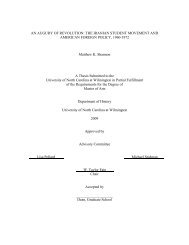Saprolegnia - The iLumina Digital Library
Saprolegnia - The iLumina Digital Library
Saprolegnia - The iLumina Digital Library
You also want an ePaper? Increase the reach of your titles
YUMPU automatically turns print PDFs into web optimized ePapers that Google loves.
CONFIRMED RECORD: -- GERMANY: Minden (loc. cit.).<br />
EXCLUDED TAXA<br />
<strong>Saprolegnia</strong> androgyna Archer<br />
Quart. J. Microscop. Sci. (N. S.) 7:123, pl. 6, fig. 1. 1867<br />
Humphrey (1893) assigned this species to Aplanes, but it is doubtless an Achlya,<br />
and is so treated here.<br />
<strong>Saprolegnia</strong> bernardensis Harvey<br />
J. Elisha Mitchell Sci. Soc. 58:22, pl. 3. 1942<br />
This is an illegitimate name, having been published without an accompanying<br />
Latin diagnosis. <strong>The</strong> specimens as described by Harvey were probably only forms of<br />
<strong>Saprolegnia</strong> ferax. Upadhay (1967) reported finding this species in Brazil.<br />
<strong>Saprolegnia</strong> candida Kützing<br />
Species Algarum, p. 159. 1849<br />
<strong>The</strong> filaments (hyphae) were described as having obtuse apices. Kützing (loc.<br />
cit.) placed Agardh’s (1824) Leptomitus candidus into synonymy with <strong>Saprolegnia</strong> candida,<br />
but from Agardh’s description, it would appear likely that he was indeed describing a<br />
Leptomitus. This being the case, and assuming that Kützing was correct in his decision,<br />
S. candida was probably a Leptomitus.<br />
<strong>Saprolegnia</strong> capitulifera Braun<br />
Betrachtungen über die Erscheinung der Verjüngung in der Natur..., p. 20l. 1851<br />
<strong>The</strong> fungus described by A. Braun (loc. cit.; 1853) was doubtless an Achlya, but in<br />
writing of the “fruit clubs” (sporangia), he stated that they were imperfect because new<br />
ones did not grow through the emptied ones as in <strong>Saprolegnia</strong> ferax. Clearly, Braun saw<br />
spore formation and discharge, and oogonium and oospore development, but was<br />
unaware of the significance of the latter. <strong>The</strong>re is insufficient information in his account<br />
to identify this Achlya with certainty. Schröter’s (1889) contention that Braun’s species<br />
was Achlya prolifera is not supported by direct evidence.<br />
<strong>Saprolegnia</strong> corcagiensis Hartog<br />
Quart. J. Microscop. Sci. (N. S.) 27:429 f. 1886-87<br />
It is likely that Hartog was dealing with a mixed culture, since the sporangia of<br />
this species as he described them were of a leptomitaceous fungus, and the oogonia of<br />
652
















